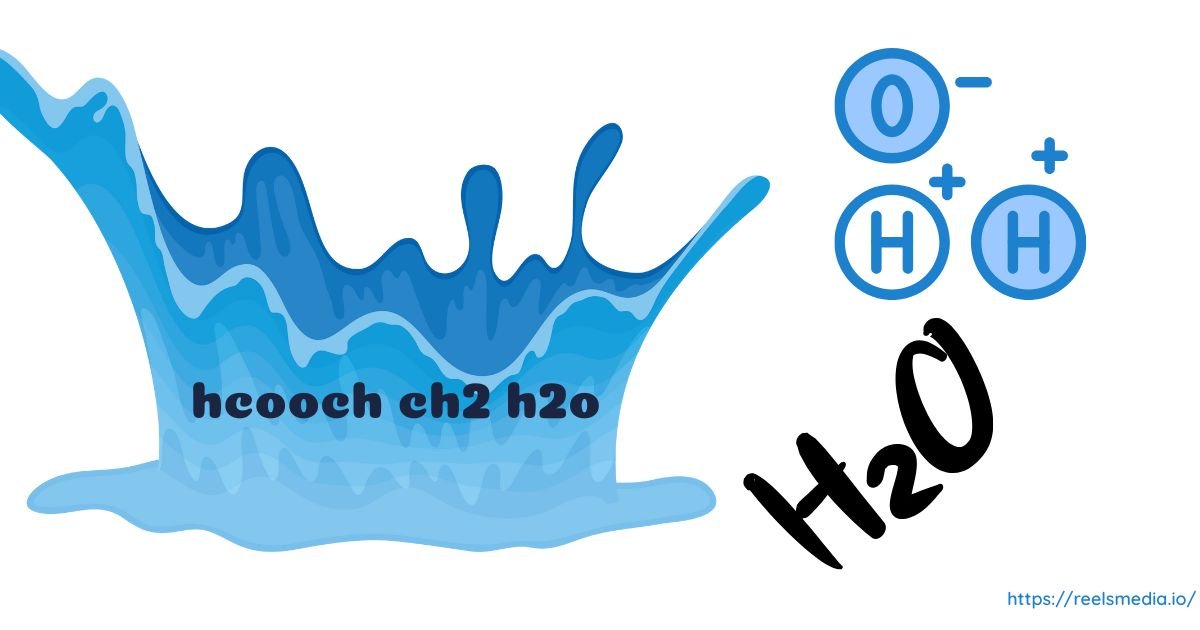When I first came across hcooch ch2 h2o, I was fascinated by how this mix is often misunderstood in organic chemistry. Many students, chemists, and even sustainability enthusiasts like me wonder about its reactivity, components, and role in industrial processes. From an academic and environmental science view, it is connected with methyl formate, sustainability, and applications in the field of research. For me, exploring this molecular trio feels like uncovering the hidden significance of commercial chemistry that supports both career and future in the organic world.
Understanding the Components of hcooch ch2 h2o
Breaking it down, formic acid (HCOOH) is a small carboxylic acid with unique properties like density 1.22 g/cm³, boiling point 100.8°C, and molecular weight 46.03 g/mol. It has been used in textile dyeing, leather processing, and even agriculture due to its role as a reducing agent. Then comes methylene (CH2), a reactive intermediate in pharmaceuticals, plastics, and polymers, with a molecular weight 14.03 g/mol and a boiling point -92.2°C. Finally, water (H2O) is a universal solvent with density 1.00 g/cm³, molecular weight 18.02 g/mol, and boiling point 100°C, helping in hydration, hydrolysis, solubility, proton transfers, and stabilizing reaction rates.
The Hydrolysis of Methyl Formate
One of the fascinating reactions is the hydrolysis of methyl formate (HCOOCH3), where water acts as a nucleophile. During this reaction, formic acid (HCOOH) and methanol (CH3OH) are formed in a process that involves protonation, nucleophilic substitution, and bond cleavage. The intermediate goes through deprotonation, and conditions like temperature, catalysts, and pH can shift the equilibrium. In my own lab experience, using acidic or basic conditions helped me optimize the reaction pathway, making it clear how chemistry balances excess with controlled outcomes.
Industrial and Lab Applications of hcooch ch2 h2o
I have seen applications of this system in textile processing, where it improves dyes and aids rubber production through latex coagulation. In fuel cells, formic acid helps regulate pH while supporting organic synthesis, hydrogenation, and polymer synthesis. This combination improves elasticity in resins and supports catalyst screening in laboratory experiments. Beyond that, agrochemicals, pharmaceuticals, esterification, and monomers show how controlled catalysts bring innovation to different industries.
Safety and Environmental Considerations
Working with methyl formate, I always followed safety precautions because it can be an irritant. Formic acid is corrosive, so gloves, goggles, and proper ventilation are essential, especially when handling toxic methanol. Direct inhalation or skin exposure is harmful, making protective gear non-negotiable. On the environmental side, acidic effluent, waste treatment, and methods to neutralise toxicity are crucial for reducing air pollution, VOC emissions, and protecting water resources. Personally, I prefer sustainable recycling to minimize disposal problems.
Addressing Misconceptions About hcooch ch2 h2o
There are many misconceptions about this chemical. Some believe it is a stable molecule, while in reality, it is a reactive system that needs careful handling. Others think it is inherently hazardous, but in most industrial and lab cases, the reactivity is useful within a narrow controlled space. I used to see it as confusing, but once I understood the iupac formula and how a shorthand can be misunderstood, the idea of green sustainability made more sense.
Why hcooch ch2 h2o Trending?
Today, chemistry lovers are buzzing about hcooch ch2 h2o in laboratories and industry due to its role in sustainability and eco-friendly applications. Advances in technologies and materials highlight hydrolysis, organic synthesis, and green demand in textiles, rubber, and energy. I noticed this buzz spreading on social discussions, where versatile processes and industrial efficiencies make it both popular and curious.
Chemistry Behind Formic Acid Methyl Ester and Beyond
Looking closer, formic acid methyl ester shows how functional groups like carbonyl and hydroxy influence chemical processes. In pharmaceuticals and agrochemicals, this molecular balance creates interactions that push new research further. For me, connecting hcooch ch2 h2o to larger patterns reveals the subject’s wide reactivity and hidden strengths.
Chemical Significance of HCOOH CH2 H2O
The chemical significance of hcooch ch2 h2o lies in aqueous acid-base oxidation reactions and its role as a proton donor. Methylene (CH2O) connects with formaldehyde, methanol, and other intermediates in pathways where solubility and equilibrium shape the rate of products formed. When I studied it, I realized how its reactive nature drives deeper possibilities in chemistry.
Future Research and Innovations
From a personal perspective, the future is tied to green chemistry with bio-based and biomass methods producing methanol. Advanced catalysts improve efficiency, while sustainable, cleaner processes push toward alternative fuels. I believe portable hydrogen fuel cells will rely on the unique behavior of hcooch ch2 h2o, making research an exciting journey for upcoming chemists.
FAQs
Which components make hcooch ch2 h2o?
The main parts are formic acid (HCOOH), methylene (CH2), and water (H2O). Together they form a reactive ester organic group with interesting interactions.
What are the common uses or applications of hcooch ch2 h2o?
It plays a role in chemical synthesis, reactions, methyl formate solvent, polymers, fuel cells, pharmaceuticals, agrochemicals, textiles, and rubber compounds that use CH2 with water.
How does water (H2O) interact with HCOOH CH2 in chemical reactions?
Water acts as a solvent and reagent, often enabling ester hydrolysis and decomposition. It supports interactions with methyl formate and methylene in these processes.
Is there a mistake in the chemical formula hcooch ch2 h2o?
Some experts see it as a discordant misrepresentation. The IUPAC system does not fully sanction it as a bonding structure, but as a shorthand misunderstood formula used in context.
What is CH₂ methylene?
CH2 methylene is a reactive organic carbon group, widely found in plastics, polymers, and drug synthesis. Its behavior connects with multiple chemical systems.
Why is hcooch ch2 h2o trending?
Because of eco-friendly sustainable chemistry applications in industrial laboratories, green research, and rising interest popularity, it is gaining recognition in both industrial and academic spaces.
